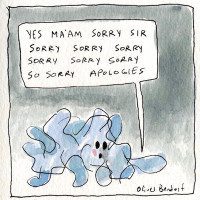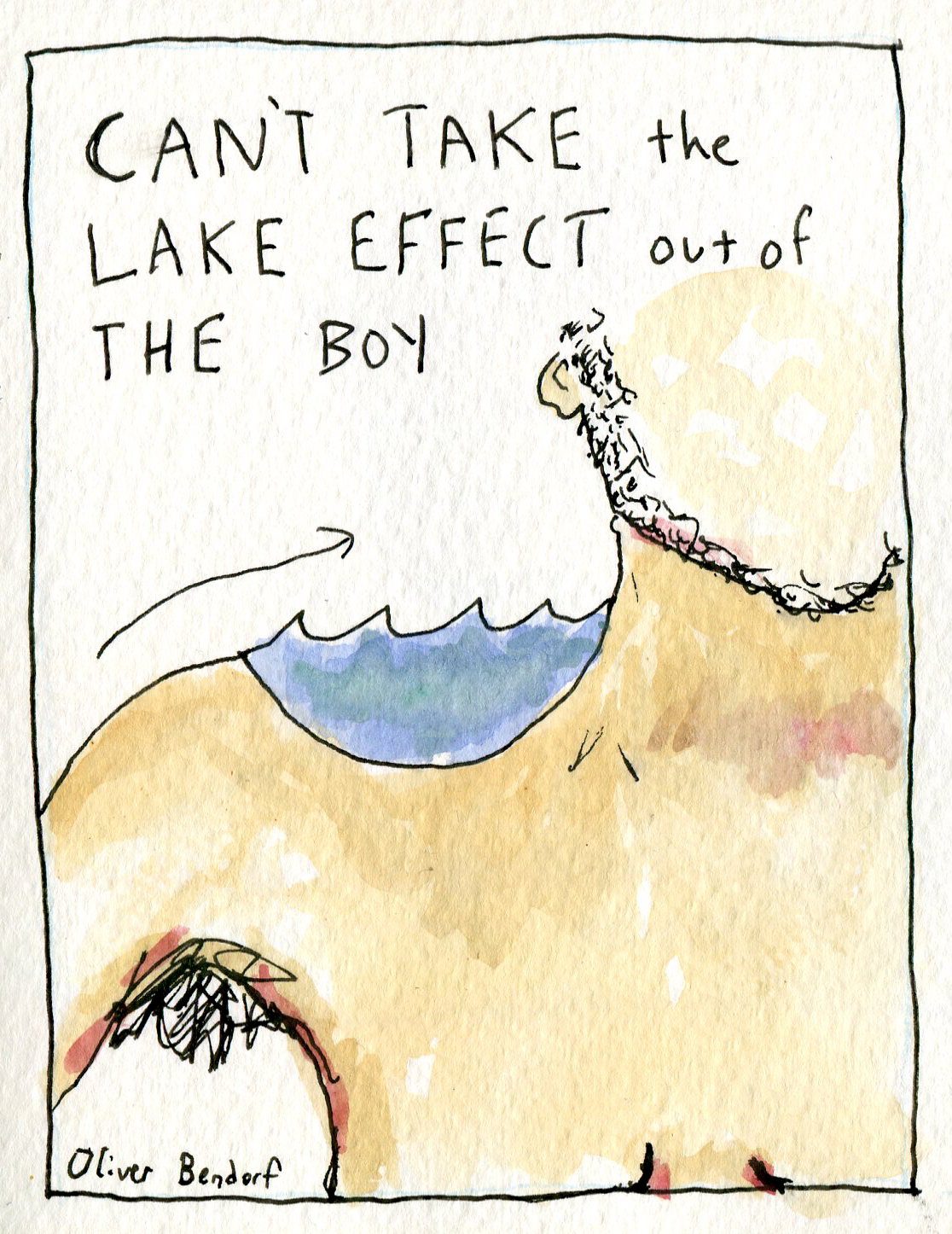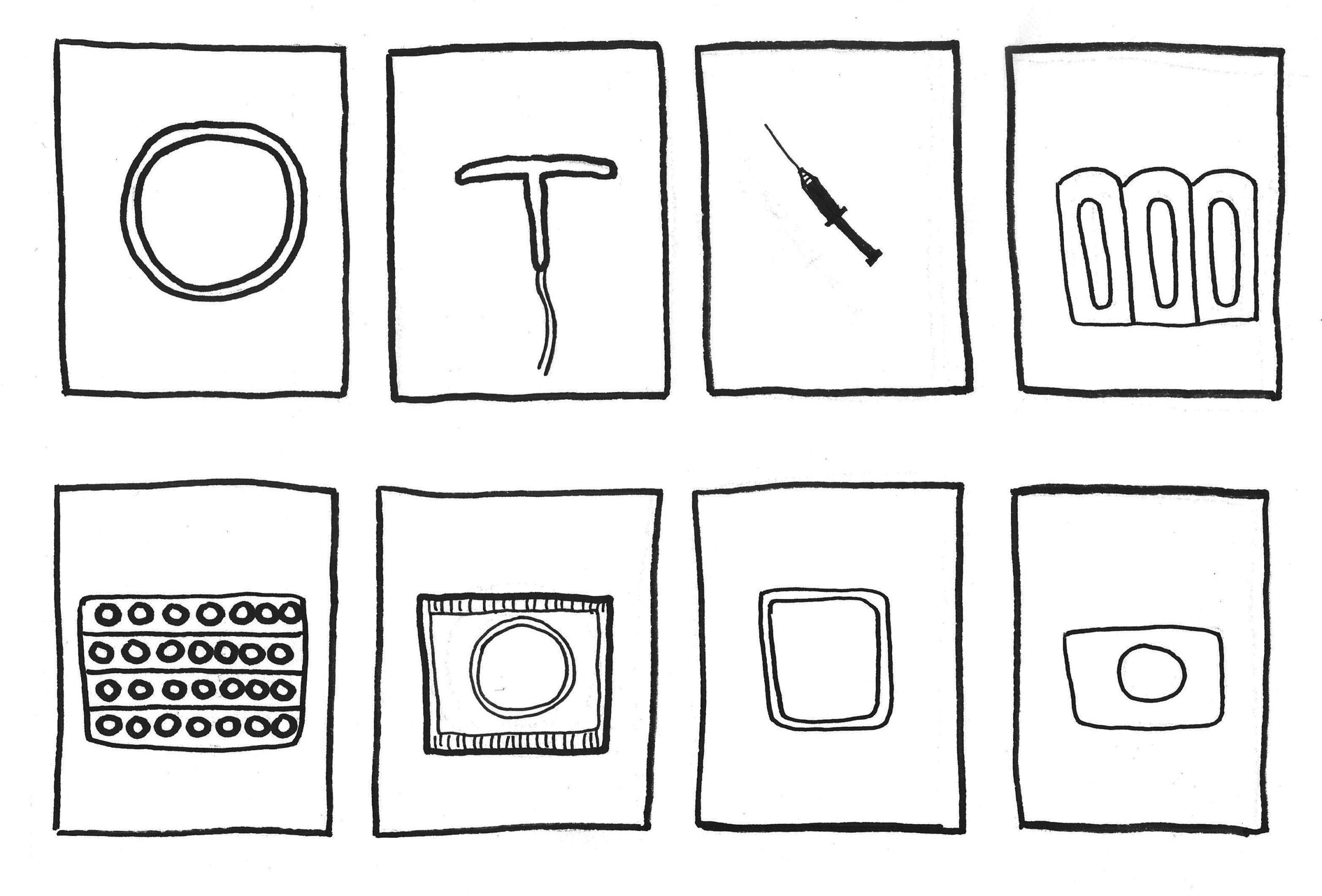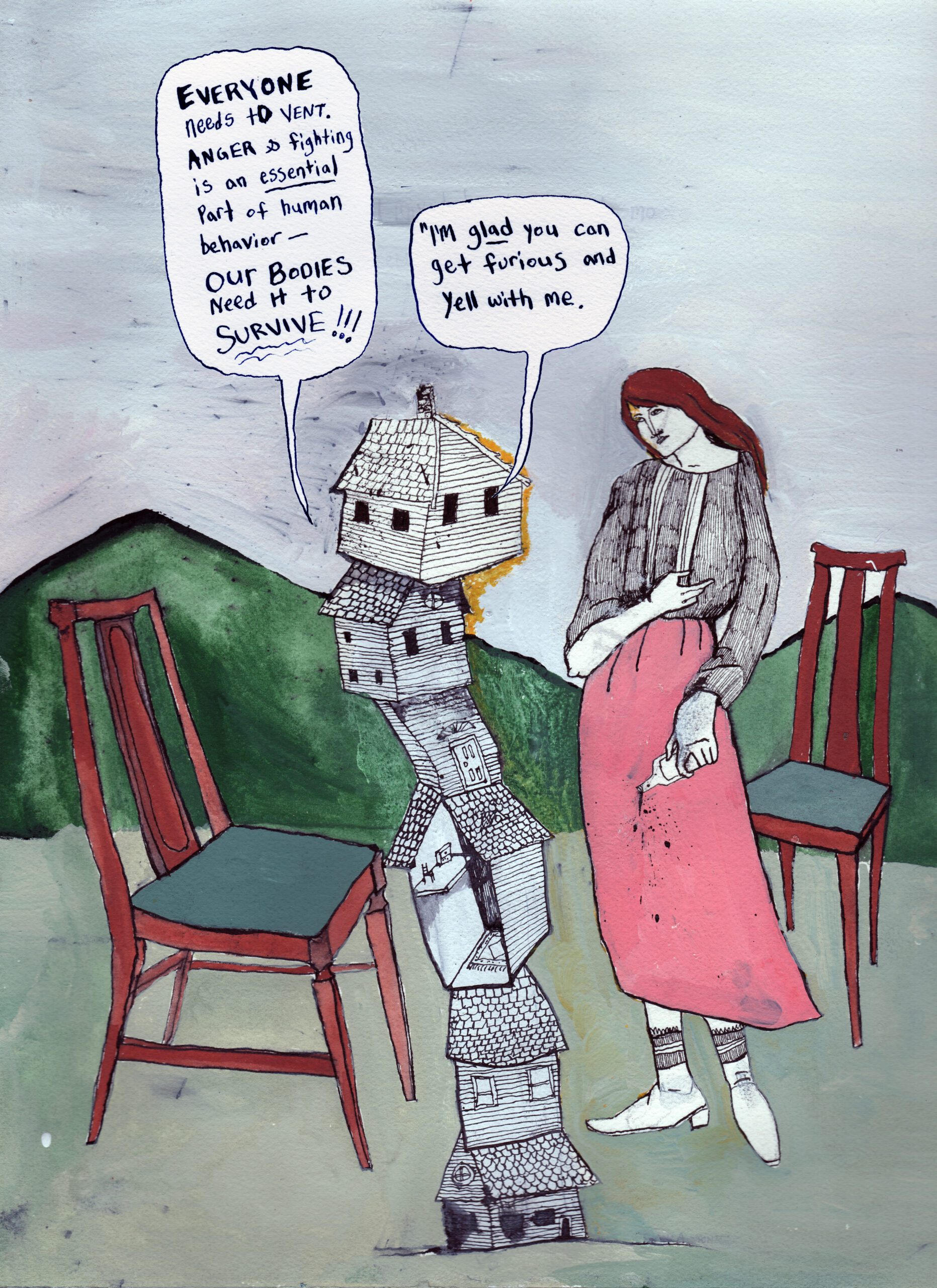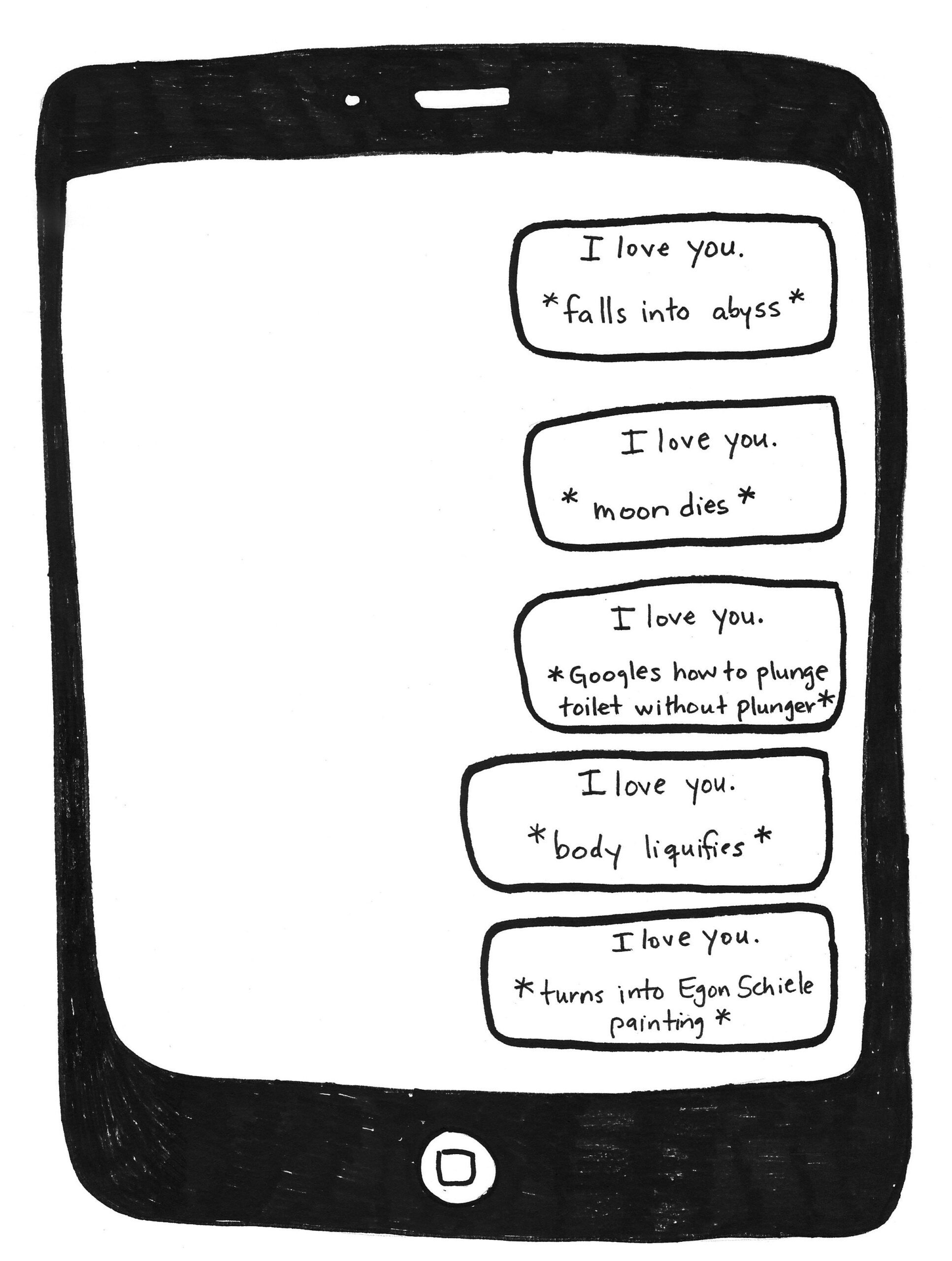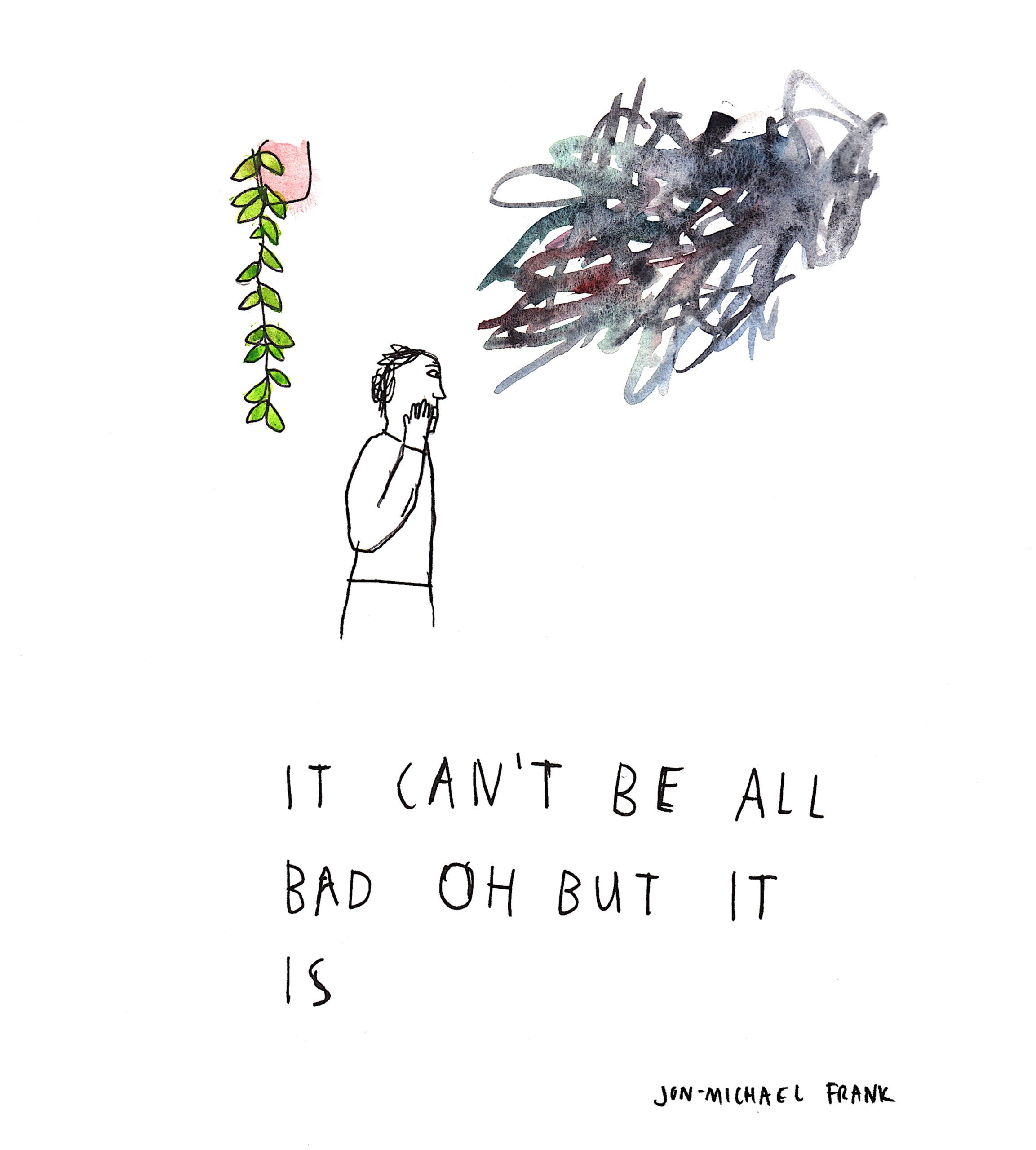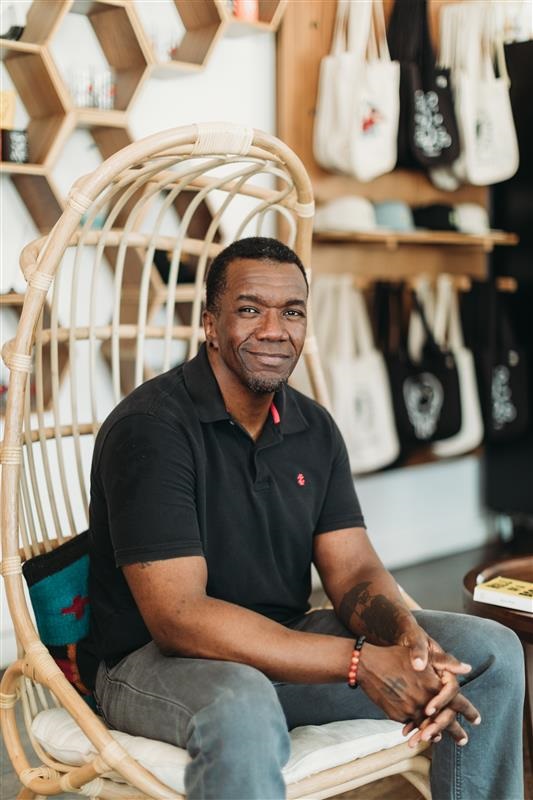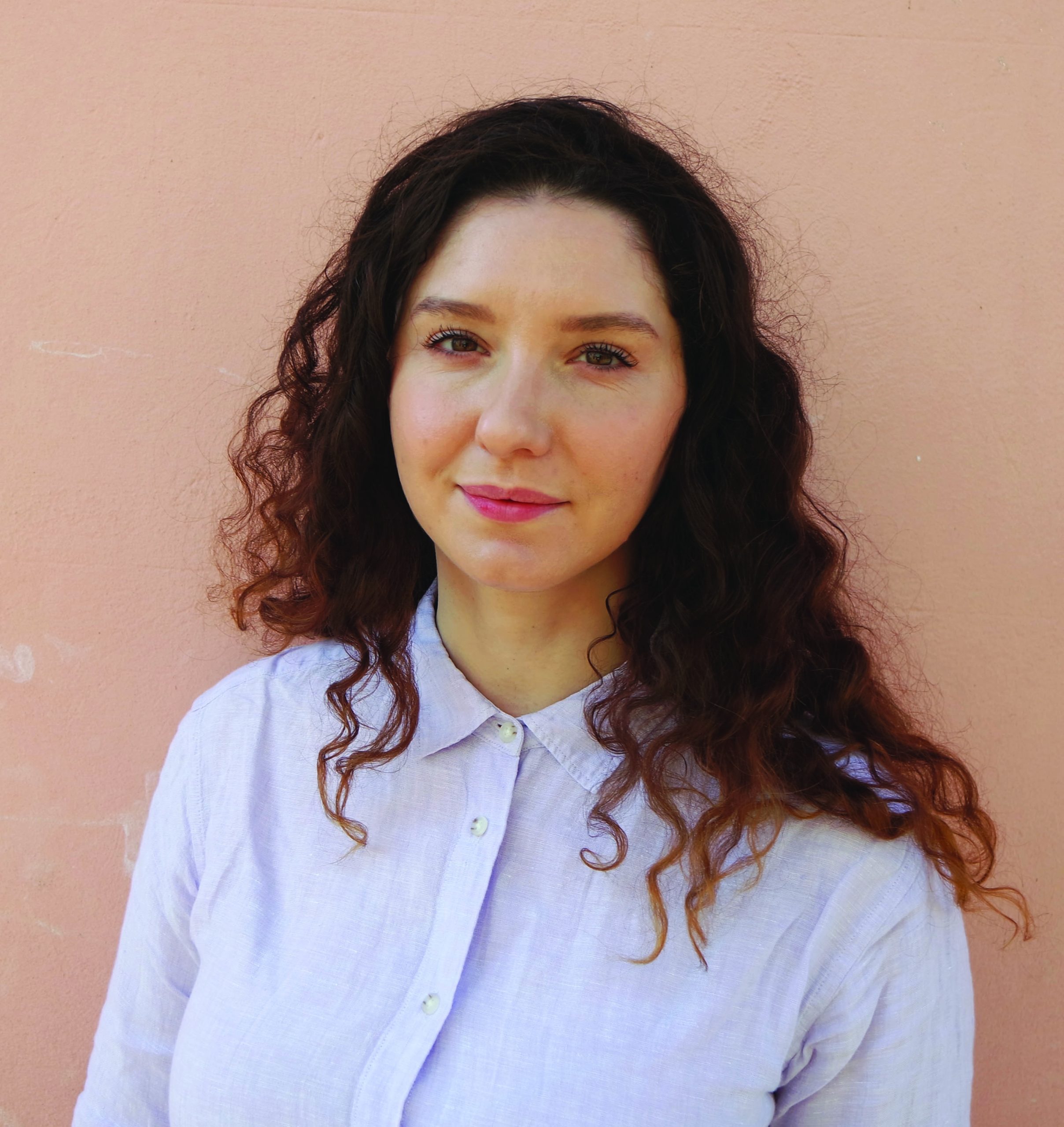My introduction to the world of poetry comics came from the experience of co-publishing (with Cuneiform Press) Jon-Michael Frank’s book, How’s Everything Going? Not Good, and talking with Jon-Michael about the fact that his book is sometimes being shelved in the poetry section and sometimes in the comics section. When does a piece of text and an accompanying image become a poetry comic? What are self-proclaimed practitioners of this form trying to achieve with it? I gathered Frank as well as poetry-comics makers Sommer Browning, Bianca Stone, and Oliver Bendorf on a cozy Google doc to discuss this emerging form.
***
Amy Fusselman: First off, I’d just like to hear from each of you in terms of how you view your own poetry-comic work within the literary landscape now. Do you feel you are forging a path? Are you part of a burgeoning movement? What has it been like to publish work like this?
Sommer Browning: Forging a path! That sounds romantic. I like romantic. I am romantic when drunk enough. But I do not feel like that. I feel like I am always trying to get Joe Brainard and Ron Padgett to give birth to me, and that will never happen. But do I ever really think about this and them when I’m making a drawing? No. I just think—weekly, daily—gee, drawing a bunch of birth control would be a hilarious comic. Boy, it would be funny to see a drawing of when you’re on the toilet and you look back behind you to check your toilet paper. But in honesty, I know there are more and more folks drawing poetry comics and it is wonderful. So, though I would hesitate to call it a movement because I hesitate to call anything anything, it’s probably a movement. And I like that. I feel like cartoons next to, with, beside, inside of poems keeps poetry in check. Kicks out anything that could be considered highbrow. Fine with me.
Jon-Michael Frank: I’m wary to use any of those distinctions with my comics, but I am excited by any potential for poetry to be less poetry-esque… I mean memes, Twitter, and most Internet lingo, is pretty much poetry, or at least a poser of it, to me, at least… I do think that Bianca has a secret to something that the modern community, literary/art world, isn’t quite hip to yet and I think she’s plowing something exemplary into the landscape that is much needed.
Bianca Stone: When someone, like, might introduce me during a conversation as “Bianca who does comics” I’m feel a bit taken aback, since I don’t think of what I do as simply comics—but it’s a very specific thing I (we) do and isn’t easily explained. Since comics are a visual art medium that almost always includes text, (besides many other similarities we’ll discuss…), Poetry Comics seemed the best term for me to use. But it’s being constantly redefined right now. It’s being explored. It isn’t fully matured, and that won’t happen for a long time. Hopefully never. Lately I’ve been thinking about it as a reaction to the Internet age. The continuous confrontation with text and image, and making sense of the two together to make a third thing. It’s an incredible place to be as an artist, to be defining a new term—that I don’t believe is a school or a dadaist-like thing. It’s a new way of talking about a wholly autonomous genre. A genre both outside of poetry, outside of comics, but built upon those two arts’ core, orphic fundamentals.
There’s a freedom in defining poetry comics for us, being able to pluck from the past and mold as we go, creating a genre like little gods! I feel so lucky to have such a passion for it. So lucky to explore and be at the beginning.
I’ve come to realize that what is poetry can evolve; we’re part of the trajectory of modern poetry, and if we stick to it, and do it well, it will stay.
Just to go back to the point of it being slightly frustrating (but totally understandable) that people don’t quite “get it,” I think that speaks to the larger issue of poetry being misunderstood, that there’s something TO get, like a riddle, like a clear story with a beginning/middle/end/meaning. The irony with poetry comics is that people are so immediately receptive to visual work, and thus they have something more to “hold onto.” What I’m saying is, people like images. They like comics. It’s more universal in accessibility than poetry is, so it’s not hard to find places to publish it, or people to react to it. I think it ends up that reading poetry comics sheds some light onto how a poem works, too, which is great. For me this is a lot about pushing poetry into people’s lives, getting them to accept it into their lives, because it promotes internal creativity, passion, thought, mindfulness, and general overall intelligence.
Oliver Bendorf: I feel like picture and text have been used in combination for a very long time, and Poetry Comics is a thing inside of that. I’ve struggled at times with what to call the work (and sometimes I just call it that, “the work”), have experimented talking about it through verbs instead of comics—avoidance, basically—of trying to pin it down. But, I think poetry and comics are an irresistible combination. Like Bianca says: “people like images; they like comics”. Poetry makes up for what people might not like about comics. And comics make up for what people might not like about poetry. Part of publishing this kind of work is trying to recognize it under all its different kinds of names—which is, in part, a librarianship challenge—I have a library degree, too, and I was really not a natural cataloger, to say it kindly. But there’s kind of a collocation of all the name variants: poetry comics, I always add poetry tragics here but it has yet to take off, graphic narratives, hybrid forms; I mean really, we could crowdsource a list of all the ways these things we make are named, and it would be kind of a long list. And I feel like none of those names are false but poetry comics feels the truest.
Fusselman: I would like to hear from Bianca in terms of how you do, in fact, spot a poetry comic. And Bianca, I would also love to know your response to Sommer’s idea about comics serving as a way to “keep poetry in check.”
And secondly, to the group: what in particular has drawn you to this form? What do you think that poetry comics can offer readers now that nothing else can?
Frank: For me, I first started doing comics upon completing a book of poems about the death of a close friend, disoriented love, and a family member’s addiction to heroin, so I wanted to do something that wasn’t so stuffy, and more “lol” rather than L. Sadly, the comics weren’t much more optimistic but there was a lot less thinking involved, which to me is highly favorable, and it was something, most importantly, different. I can’t be one of those people that devote their entire life to one discipline or validating whatever one thing they’ve done with their life as ubiquitously significant; I need variance. There’s also a peace and playfulness to making comics that serious work, for me, is detrimentally lacking, and thus can a) sustain you and b) usher in some amusement for life. I have zero fun writing, whereas making comics I can watch Northern Exposure and listen to Ariana Grande and laugh afterwards rather than feel like I’ve failed at something monumentally vital to my survival. For me, comics feel more like a choice rather than a consequence of my existence, like writing does.
Stone: How to spot a poetry comic! Literally it says that on the cover of my book, cheekily. It’s kind of our secret, guys, right? It’s not out yet. All we know is we’re poets and we’re not stuck with just words. There’s something… something subtle and tricky that happens in a visual piece (usually with words), when it leaves the tyrannical realm of prose and enters the realm of poetry. What is this that happens? I think it’s the essential ingredient to what makes a poem a poem. And fuck, where to even begin with that? We can start with the poetic device of a “line break,” which is a colossal feature of poem, used at the end of a line and the beginning of the next line in a poem. In a line break meaning is fragmented, even beyond what the poet is saying. And something is no longer there. There’s a purposeful vacancy, a space for the reader to create. There’s Keats’s negative capability raging away full throttle. And to me, the images function as another line of the poem, not ever explaining, but complicating and furthering the language. Thoughts?
As to Sommer’s astute observation, (sorry I’m at the whiskey and reading Middlemarch) comics absolutely keep poetry in check. A poetry comic panel amplifies the language tenfold, having it isolated like that. You better be punchy, better choose the right lines, because it’s under the spotlight when it’s all alone. And more to what the point of what I think she was saying, it deters from a poet’s “sacredness” towards poetry, which can do a huge disservice to the poem.
Browning: Yes, Bianca, I agree with that “complicating and furthering the language.” Complications, all manner of complications, are something that I need and am drawn to. I love Jon-Michael’s “I have zero fun writing”—that would in fact, make a good comic. And in order to destroy the joke, I will break it down. “I have zero fun writing,” he writes. This implicates the audience who cannot be innocent now, who are contributing to the author’s “not fun” (pain? loss? boredom?) by being entertained by it. And if it were a comic, the slyness of stating the no-fun but getting away with drawing (and perhaps letting the author have his/her fun anyway?). Other things too (I’m not good at criticism)… anyway, you can say and do these weird, slippery, sly things (e.g., implicate the audience) with poetry comics or whatever these comics are we draw. I like doing these things. You can do it with humor, too (which is why I believe it is the most amazing of all genres of communication). I like doing humorous things too. So maybe that has drawn me to this form. But also what I really like about drawing koans, poems, thoughts, is that it turns me off. It turns off my superego, my critic, my logic organ. I think everyone likes to do that and in a myriad of ways from unhealthy to productive. I do it in a lot of ways. But in the drawing comics way as opposed to the getting hammered way, I get to keep the nice part of thinking, the generative, life-affirming part. The cognitive, sexy part.
Fusselman: This brings up the old writing/drawing issue. I would be curious to know if other participants feel similarly that one activity is much less painful than the other.
Bendorf: I came to comics after poetry, through Lynda Barry, I worked with her in the final semester of my totally word-based MFA, and I had been struggling for a year to explain the “image” in poetry when I felt I barely understood it myself. Like as a brand-new creative writing teacher I felt I had absolutely no good way to facilitate an understanding of that elusive “image” that people talk about in poems, which looking back now is kind of silly, because I’m sure I had some language to describe it. Anyway, returning to drawing in Lynda’s workshop changed everything. I started thinking about images as being a thing that can take shape both through words and through pictures. It sounds obvious, but it was not obvious to me at the time. A poetry comic is the best of all worlds. The way it squeezes out the pulp of image and pacing in the interplay between the two pleasures of reading and looking at pictures. It’s exciting. It’s fun. It’s deceptive. It offers variety, like Jon-Michael was saying. I was back at my folks’ place (then a farm in Iowa) for a holiday a year or two ago and was going through a box of my childhood art in their basement. I remember laughing out loud thinking that I’ve been making poetry comics basically my whole life. I think a lot of childhood art is poetry comics; a lot of the really amazing children’s books are too. I think even some of the nostalgic love for coloring books taps into this. Also, I worked with Lynda during my first five or so months (it was a spring semester) on testosterone, and suddenly having both drawing and writing at my disposal meant that I could document my awkward grad school second puberty of patchy facial hair and a cracking voice through the magical world of poetry comics. It was amazing. I made a poetry comics zine called Non-Photo Blue [I am not so good at transition] and I’m not sure I have any copies left but I was hooked. It’s like the combo of poetry comics necessitates or opens up a fuller way of being both a body and a… I’m tempted to just put a blank here. Of being both a body and a ____?
Browning: Ugh, Oliver! You say: “I think a lot of childhood art is poetry comics.” I love this and will think about it for a long time. Yes. Something about the unformed rules of language, the base instinct we all have that says: EXPRESS YR DANG SELF in any way with any available tools (both cerebral and physical). Kids want to express themselves. There’s a purity there and a directness I can see in the drawings we do (but of course, ours have a very real adult, matured-mind element). This is not to say they are layered on purpose with deep meaning (that all comes from the viewer or at least I like to leave it up to them) but maybe just our many more years of experience deepens and layers them subconsciously.
Bendorf: I really love that, Sommer, about poetry comics being a kind of cooked-down-on-the-stovetop version of that same childhood directness. Ivan Brunetti says in an interview somewhere that he believes his best artistic period was his childhood. I work my way through his Cartooning: Philosophy and Practice book a lot.
Fusselman: Also, Sommer, I would love to know more about The Circle Book because I think it functions so beautifully first and foremost as a poem—it’s pure metaphor. But it is also a comic—and yet the artwork itself undercuts the notion of how art in a comic book operates. When I first read it I thought it should be in every children’s library in America—so simple, yet not!
Browning: The Circle Book was first a one-page comic with dozens of little circles with captions, then to make the book I gave each circle a page. I feel it was important for me to draw each circle and I am not sure why. One guess is that when folks ask, “Did you draw every circle?” I can say, “Yes.” That is a question people ask. Does that somehow make it more authentic? Another thing people say about that book is they give me other captions, circles I didn’t think of. I love that so much and it is an important part of how that book does its job. Is that verging on some aspect of the definition of art? That the art object gives imaginative space to the viewer? Not to derail the entire conversation, but my friend, the poet Shannon Tharp, helped me realize the other day that art can sometimes function like this: It points out the world’s faults so excruciatingly beautifully that it makes the viewer fall in love with this faulty world. God, I love that. Am I saying this might be why there is suffering in the world? So that we can digest it and transform it, experience that transformation, feel awe, and then decide to go on living for one more year, day, hour? Christ, some theologian poet has probably already said this, but it is giving me energy for the moment.
Frank: Sommer! I’m in love with that faulty world comment! If there can be any use for a tombstone, saying things like that should be it. Meaning, will you poetry comic my tombstone?
Browning: Yes! I hope you die a thousand times so I can poetry comic your thousand tombstones! (This happens to be one of my definitions of love, that “hoping you die multiple times” thing. Explaining makes everything worse. Sorry.)
Frank: “Explaining makes everything worse.” Perfect comment when discussing an obscure, or ambiguously emerging art form. How about we use that for my first death tombstone, “Explaining makes everything worse”? Death virgins.
Browning: Yes. Hahaha. So funny. And “Death Virgins” is our new band. I hope you can’t play anything and we never have to practice. You can’t even play foosball. Like not allowed.
Frank: Can you start a Bandcamp page for silence? Kickstarter? I hope we don’t kill this. I love how bad these jokes are getting.
Browning: Killing is the new living. (Me, too.)
Fusselman: I love this idea that the images in poetry comics are not only making the poems more accessible but that they enlighten the poem themselves. This strikes me as particularly bold given the notion of poetry as a pinnacle of enlightenment. With this idea of poetry comics as a democratizing force in mind, I wonder if any of you have thoughts on poetry comics as an inherently political art form?
Frank: Political, no, not for me… I mean isn’t anything that resonates with people slightly political in some fashion? So I guess it’s ineluctable, in a way. But I think there’s this tendency to accuse movements, or epochs, as having some sort of end game or agenda, and I think that’s where people start to get self-conscious about what they’re doing which in turn changes the narrative or the stream or the impact of it. The one thing I love about a burgeoning of any sort is its wild disregard of purpose and function. It’s just for this short time, a thing that needs or wants to be, without seemingly the effect of its own existence, i.e. that it must end. It’s something that seems impossible in real life but in art it becomes a little more accessible. When the politic emerges, that all seems to break down; it’s experienced for utility rather than, just, experience. They tried to do that with LSD. I mean, I guess a lot of people tried a lot of things with LSD, but the nice thing about LSD, and things of that ilk, is that they aren’t useful, in an industrial sense. How refreshing of an idea! An anathema to the modern era! I think this same idea can be applied to poetry comics, in that, similar to what Bianca was saying, images reward people to experience rather than manipulate information they’re processing to some kind of “end” or “solution.” Isn’t the point of making art—or making anything—that there are no real solutions?
There’s a dichotomy, I think, that happens between the visual and verbal disciplines when an audience is introduced. Images allow people to still feel a part of the world, and process and accept from a distance, whereas words bring you right into it, and the experience is very personal and/or intimate, and if the information you are receiving is too unwieldy, I think a lot of people immediately shut down. Looking at a strange or surreal painting incites that wonder for the world that we wish was brought on just by getting up every morning—something words can only do if you give them permission; there’s a consent involved. But with images, just like the world, there’s no consent. They are there regardless, sort of ontological in a way, a take-it-or-leave-it kind of thing. This means with images, you are still just looking at the world; you are in the same state; there isn’t the sudden shift that happens when entering a good poem that can fuck everything up for you. People avoid trying to be fucked up by stuff they don’t understand. Just tell someone you don’t know that you love them; they will lose their shit. I think the solution we end up adopting is: don’t get fucked up by stuff, and that’s when life, or expression, gets super stale and barren.
Sommer and I have written many emails back and forth about our love for the weird. From 1980s bizarre-worlds of Paul Kirchner’s The Bus and Luigi Serafini’s Codex Seraphinianus to marvelous contemporary artists such as Joan Cornellà and Maren Karlson. Sommer, do you have any preference over your experience of the surreal either visually or verbally? We seem to love distinct realms and worlds; why do you think you’re/we’re attracted to that type of universe? And lastly, how do you think they work best together?
Browning: No real solutions. Yes. With images there is no real consent. That is so interesting. I have never thought of it like that. What about that immediacy is important or amazing about visual art as opposed to the cognitive work (is it even using a different part of your brain?) of reading. Jon-Michael, do you think that part of this is temporal? Like the time it takes to read vs. the time it takes to see? Perhaps time is a factor in that sudden shift you are talking about? I remember an old boyfriend commented on how I had to read everything all the time. We were sitting down in a movie theater and there was a newspaper in the seat next to us and I just immediately picked it up and began reading. There is something so enjoyable about processing and thinking and conjuring and drifting off with all that in your head.
I think that is partially an answer to your question, Jon-Michael: why do you think you’re/we’re attracted to that type of universe? Those worlds make me process, think, and conjure and I find that sensually pleasurable (aka “interesting,” if we don’t want to blend our minds and bodies). But also, I like to be uncomfortable. I enjoy it because it is interesting. It is expansive. And I am sure there are some psychological reasons going on. I would rather sleep on the floor. I would rather order the most disgusting thing on the menu. In general, I’m not sure why pleasurable, nice, and pretty are considered “good” or something to strive for, or an end in themselves. Discomfort, difficulty, complexity—these are just different feelings and experiences. They are neither good nor bad. This is a longer conversation for elsewhere. But I think these dystopian visions of the world or weird imaginative spaces you’re talking about provide all those other interesting, different experiences I seek.
Bendorf: This is going back for a second to the question of poetry comics as being or not being political (a question we maybe we never left). I do feel like the same potency of the image-text combo that we all love is also what can make it a kind of, I don’t know, political combo. Somehow more provocative than either medium in isolation. More prone to conflict. I remember thinking this when I was getting my library degree, learning about case after case of graphic novels being challenged at libraries or banned in schools. Sherman Alexie’s amazing Absolutely True Diary of a Part-Time Indian is banned all the time. Would it be banned any less if it didn’t include drawings? I don’t know, but there does seem to me to be something about the “graphic” in graphic novel that can set people off in a way. Like what’s actually graphic about a graphic novel? Persepolis, by Marjane Satrapi, I remember reading somewhere that it was important to her to draw the faces as simplistic as possible, to have her characters seem more human and less foreign. But I don’t know if that’s an example of image-text being political or of its capacity to be apolitical. Or not even apolitical but, like, sub-political? Now I’m just throwing random prefixes around. I think I’m more interested in poetry comics as being human than in being political. I like everything Jon-Michael and Sommer said above, about experiencing the world.
Fusselman: What work of other poetry-comic makers (and these may not be people viewed as poetry-comic makers) is inspiring you all right now in your own processes? And also, what are you working on?
Bendorf: I have to come back to the first part of the question, but as for the second part, right now I’m working with Temim Fruchter on this neighborhood pop-up poetry project here in Mt. Pleasant, DC. We’re calling it the Mount Pleasant Poetry Project and here is a secret sneak peek at the website that I’ve been working on around the clock to get ready.
Two other projects I’ve been working on in my head: A couple people have asked me lately for tips on drawing as an adult, and the more I thought about it the more I felt like what would be useful is tips on adulting for draw-ers (this has a branding problem because without the hyphen I picture wooden chests trying to adult, which is not what I mean but maybe?), so that’s a project I’m working—compiling some tips from that angle… the angle that presumes everyone to be artists first, presumes creativity first and capitalism second, and what adulthood demands of us. The second project is an illustrated self-help book called How to Make It that’s about making shit as a way to cope. Because life.
As for the first question, Lynda Barry is always fueling me. A lot of stuff from Siglio Press. My pen pal Sebastian Matthews. All of you, this conversation, right now.
Browning: I love those book ideas, Oliver. They will totally be blockbusters. Yes, adulting for drawers. Because let’s face it, art is real life. It is this annoying, boring, systematic, fake-ass adulthood that gets in the way. That’s what we need help handling. What a great approach. I love these people: Julie Doucet (but she doesn’t really draw anymore), Zak Smith, Joan Cornellà. And I’m currently very into a book by Dale Pendell that my friend, the poet Whit Griffin, suggested. It has lots of images of demons, saints, monsters, religious symbols in it, but is a kind of hallucinogenic plant encyclopedia that mixes science, poetry, drug diary experiences, and visions. It’s called Pharmako Gnosis. I’m transfixed by it right now. As far as comics that I’m working on, I am just drawing one off type things and getting a manuscript together to send to a friend who might publish a book of my comics later this year. I am recently very into drawing my cell phone and real messages from people, mostly messages between my lover, Ben, and me. I love the idea of drawing a cell phone. Analog vs. digital, sure, but there is also something so strange about drawing communication. Like drawing a letter? Drawing a page of a book? I like something about it. And I have about six or seven writing projects I’m working on. I have been incessantly starting projects recently. And Solid Objects will put out a book of poems by Noah Eli Gordon with drawings by me later this year.
Frank: Adulting for drawers. I keep thinking like a chest of drawers. I wonder if aging sucks for them too, like if life can too get boring for something as boring as a chest of drawers. Sorry, this is stupid. I love the idea of How to Make It though, Oliver! I feel like I could benefit dramatically from a book like that. I remember proposing to Sommer about collaborating on a book of comics (or a book of something) called Things to Do Instead Of Killing Yourself. I think as far as I got with the idea was things like, get a minimal wage job, get your cartilage pierced at Claire’s, and/or apply to grad school. Maybe that’s as far as we all get though. Sadly, Sommer never responded. Hey Sommer, maybe you can use that premise for one of your new message comics. Too soon?
Browning: Oh almost forgot, I’m working on a book with Jon-Michael (you jerk) called Things to Do Instead of Killing Yourself. The first comic will be me responding to Jon-Michael.
Frank: Anyway, projects I’m working on next are 1) a real life garden, and 2) poetry stuff. I’ve got a poetry chapbook coming out hopefully in the next few months from Birds, LLC called Disintegration that’s a collection of love songs, like from a hole or something. The wondrous new press wing of Witch Craft Magazine is nice enough to be putting out another chapbook of mine called Nostalgia Flower that features art and poems and which I want to feel like the reader is looking at a hypnosis spiral through the eyes of a BDSM mask. And lastly, I’m finishing up edits on a full-length collection of poetry tentatively titled Dream Creature which I’ll hopefully be sending out to prospective presses this year. Ta da!
Stone: Right now I’m working on gigantic oil/acrylic paintings and poetry. So far my big paintings don’t have words in them. But they do look like giant versions of my poetry comics. It’s such a different way to work. I can drive myself crazy with one thing for much longer. They sit in my living room haunting me. I’m having issues finishing them; I just keep tinkering and layering. It’s just such a different process, time-wise; an exercise in patience. I can work on one foot for an hour. I feel very grand doing it. Have you guys ever gone giant? It’s super fun; it is like an enormous punch in the face every time you walk into the room and see it. Scary shit. But good scary.
The other thing I’m working on is my next full-length book of poems. I’ve been working on these surreal biographical elegies, meditating on death, passion and sexuality. I’m calling it The Mobius Strip Club of Grief. In The Mobius Strip Club of Grief the women are XXX.
Browning: Bianca… best title.
Stone: My new poetry manuscript is really inspired by exploring the elegy and the ekphrastic in lyrical poetry… beyond the ordinary aesthetic strategies of both the aforementioned forms, I have found it richly inspiring expanding on these poetic devices. It’s very much emotionally from the same place as poetry comics. As someone who is deeply invested in visual work—from within and without as a visual artist and a poet—I’m interested in the possibilities of the ekphrastic form via that bombardment of visual cues. I think of the concrete yet mystical lens of science, nature, and neurology provide unusual extensions of ekphrasis. Illuminating both the limitations and infinite possibilities of the self, the elegy and the ekphrastic are deeply rooted in personal experience, the tendency to paint the self (natural to a writer), but also are a conversation with artists who have come before, the living community in universal struggle. While ekphastic poetry permits the joys of the possible, the elegy allows exploration of the arresting limits of what is possible. (Phew! Can I have my fellowship now? Lol.)
It’s not poetry comics. As any of us in this discussion will tell you, once you put any visual art/ comics in there, that’s what people look to most. And for this I really want the words to do the work.
***
Oliver Bendorf was born in Iowa in 1987. He is a writer, cartoonist, librarian, and educator, the author of The Spectral Wilderness (Kent State University Press 2015) and co-founder of the Mount Pleasant Poetry Project, and his writing and comics have appeared in, or are forthcoming from Alaska Quarterly Review, Best New Poets, Blackbird, Indiana Review, Ninth Letter, The Rumpus, Transgender Studies Quarterly, Troubling the Line: Trans and Genderqueer Poetry and Poetics, and elsewhere.
Sommer Browning is the author of two poetry collections, most recently Backup Singers (Birds, LLC; 2014), The Circle Book (Cuneiform; 2015), an artist book, various chapbooks, and a live joke album out with Black Cake Records. Her chapbook Want to Hear About This Dream I Had is forthcoming from Reality Beach in 2016. She’s a mother, lover, friend, and librarian in Denver. Follow her on twitter: @vagtalk.
Jon-Michael Frank is the author of the forthcoming poetry chapbooks: Disintegration (Birds, LLC) and Nostalgia Flower (Sad Spell Press). He has a book of poetry comics out now called How’s Everything Going? Not Good from Ohio Edit/Cuneiform Press. Currently, Jon-Michael is the acquisitions editor for the small press Birds, LLC and lives on the Puget Sound. More at www.jonmichaelfrank.com.
Bianca Stone is a poet and visual artist, and the author of Someone Else’s Wedding Vows, and Poetry Comics From the Book of Hours. She runs the Ruth Stone Foundation and Monk Books with her husband, the poet Ben Pease, in Vermont and Brooklyn.
***
Image credits: feature image and image 3 © Oliver Bendorf, images 1 and 7 © Jon-Michael Frank, images 2 and 5 © Bianca Stone, images 4 and 6 © Sommer Browning.
